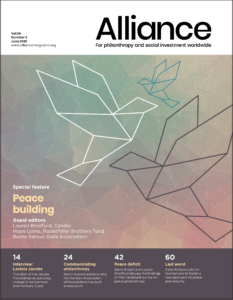Dedicated changemakers around the world are engaged in courageous and inspiring efforts to end violence and bring stability to their communities. The ‘localization’ agenda has been on the radar of the international community for several decades now, without significant results for financing local actors. It is time to focus on more effective solutions – community-led philanthropy, radically flexible grantmaking and investing in innovative finance for sustaining peace – and these require the risk capacity, innovation and flexibility of private donors.
Research has demonstrated that in complex operating environments, supporting local peacebuilders and civil society to create their own solutions is often the most constructive path toward sustainable social change. The roots of conflict are complex, and local organizations and communities know best how to address problems in their own contexts. Yet, they face a continuing crisis in financing their work. In the State of Global Giving, the Foundation Center notes that of the $4.1 billion that U.S. foundations gave overseas from 2011 – 2015, just 12 per cent went directly to local organizations based in the country where programming occurred.
Decades of literature and countless examples speak to the limited utility of donor-imposed solutions to local challenges – and yet, the biases of the international community and donor industry have made these types of solutions hard to shift. For five years, I led a team at the U.S. Department of State that managed foreign assistance to civil society organizations working on human rights issues in conflict-affected countries all over the world. I saw first-hand that short-term, prescriptive and project-specific funding is not helpful, and that lack of donor capacity to take risks or manage smaller grants often results in feeding funding through INGOs and international organizations even when the evidence in support of locally-led solutions is clear.
Pathways for Peace notes that targeting resources toward just four countries at high risk of conflict each year could prevent $34 billion in losses. In comparison, spending on responses to violent conflict through peacekeeping and humanitarian operations in 2016 was $8.2 billion and $22.1 billion, respectively. Successful strategies to address these issues should put local actors at the forefront; in order to do this, new ways of operating outside the traditional Western grant-funded paradigm are needed.
What are the most promising approaches? In partnership with Peace Direct, I interviewed 24 private funders with experience supporting local grassroots actors on a variety of issues – climate change, HIV/AIDS, education, child protection, human rights, blockchain technology, and social finance. We also wanted to hear directly from local actors about their needs, so held a 3-day on-line consultation with civil society and peacebuilders on every continent. A range of useful programmatic models emerged – from participatory grant-giving to seeding community foundations to funding ‘clusters’ of organizations working on issues thematically and geographically.
None of the donors interviewed specifically focus on funding local peacebuilders because such a mechanism does not yet exist. However, our research uncovered important lessons and new solutions to effectively supporting local actors in conflict-affected countries. Promising approaches include: community-led financing; amplifying the principals of those donors who practice true partnership and radical flexibility in grantmaking; and, developing the tools of innovative finance to sustain peace. These enable local actors to better generate, implement and scale their own solutions and processes.
There is now a significant body of evidence demonstrating that community-based financing works. Indeed, effective participatory and community-led approaches can facilitate the involvement of different groups in conflict within divided societies and serve as peacebuilding processes themselves. They also enable the perspective of actors traditionally outside of the peacebuilding field, such as economists, which then contributes to more holistic solutions to complex problems.
Local actors and donors who utilize radical flexibility in grantmaking feel they ultimately get a higher return on investment because organizations are able to focus on their technical work versus preparing supplications, fulfilling project requirements and raising money. This approach includes: creating flexible pots of money that can be deployed rapidly and enable partners on the ground to align programming priorities with changing contexts; providing core versus projectized support; shifting the administrative burden to donors by asking potential partners to submit existing organizational documents such as annual work plans and budgets rather than requiring new project proposals; and, minimizing reporting requirements. One funder simply asks: What do you want to share with us?
Innovative finance approaches present interesting models because they have the potential to leverage new sources of funding. They also flip the current foreign assistance paradigm. For example, in outcome-based funding donors/investors are only concerned about whether the project achieved an agreed upon set of objectives. Rather than rigid monitoring and evaluation plans and dependence on intermediary outputs and outcomes, this model provides key flexibility for local actors to pursue programmatic activities as they evolve and report on them as they unfold.
Overall, our research shows that the most successful approach to sustainable peace will flip the power dynamic between funders and local recipients to ensure greater agency and leadership at the community level, allowing donors to play a more impactful and sustainable supporting role. How can private philanthropy help? Through engaging donors who are willing to invest in innovative solutions to building peace from the ground up; donors who will help to pilot a new funding mechanisms to aid local peacebuilders; and, donors who aren’t afraid to take risks that will change the current funding paradigm.
Riva Kantowitz is an independent consultant working on peacebuilding financing in partnership with Peace Direct
 Peace-related philanthropy, at less than 1 per cent of all grantmaking, seems irresponsibly small given that armed conflict spoils lives, divides societies and ruins economies.
Peace-related philanthropy, at less than 1 per cent of all grantmaking, seems irresponsibly small given that armed conflict spoils lives, divides societies and ruins economies.
Our new issue goes in search of philanthropy’s role in peaceful development.



Comments (2)
Glad to see these issues more spoken about. The localisation of aid agenda need some more traction as we keep seeing repeats of local people brushed aside. We are writing our story about how aid doesn’t but should make it to local people. #unitednonsense After a decade in the field we saw the worst of what happens when the system refuses to recognise share power. Tech solutions will also bring new mechanisms disrupting the current aid paradigm. We are working on a project in Raqqa with FrontlineAid on just that..Great article. Thanks.
A terrific set of principles for effective funding. These same principles have proven valuable in other sectors, so it is good to see that they work in peacebuilding as well.